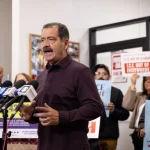

Presidential candidate Robert F. Kennedy Jr. believes he can get on all 50 state ballots in time for the 2024 presidential election.
“One hundred percent — we will be on the ballot in all 50 states and the District of Columbia,” Kennedy campaign press secretary Stefanie Spears told the Washington Examiner.
Ballot access serves as one of the biggest barriers to Kennedy’s long-shot campaign, as he attempts to take on the full might of the politically dominant Republican and Democratic parties. With the recently announced presidential debates, there is new pressure to make it on as many ballots as early as possible. CNN has confirmed that only candidates who attract at least 15% of the vote in four national polls or have shown they are on enough ballots to theoretically collect 270 electoral votes will be considered for the debate. So far, the Kennedy campaign has claimed access on 15 ballots, with Decision Desk HQ confirming ballot access in Michigan, Oklahoma, and Utah. Those three states total 28 electoral votes.
According to the campaign, it has also successfully petitioned Ohio, New Hampshire, Nevada, North Carolina, California, Iowa, Nebraska, Idaho, Delaware, Hawaii, Texas, and most recently, New Jersey. Altogether, those states constitute 201 electoral votes.
At first glance, the assortment of states does not appear to have any rhyme or reason, including both big and small and Republican and Democratic states. A Kennedy campaign official told the Washington Examiner that the reasoning behind the ballot access push is simply a matter of when access is allowed.
“To us, they’re not eclectic,” the official said. “The way that ballot access works is there’s … states … now almost every state is open, but every state is different. So when we initially started our ballot access, we broke our states up into four different tiers.
“So tier one would be a state where you could start collecting signatures where you didn’t need electors to turn your signatures in,” the official continued. “And you also didn’t need a VP pick. So those were nine states, which equaled 108 Electoral College votes. And then … tier two, you needed your electors, but you didn’t need your VP because we didn’t … announce our vice presidential pick right away.
“So for us, it was strategic from the start, based on which dates you could … collect in and then finalize,” the official added. “We also determined which states we focused on based on how long the window was open and when their deadline was.”
The two hardest states to gain access to are New York and Texas, the official said, due to how short the window to apply is. New York only has a window of roughly six weeks, resulting in the campaign focusing many resources on it in the past weeks before the window closes on Tuesday.
Campaigns to get ballot access are largely unrelated to campaigning itself, the official said, so the campaigning strategy does not change.
CLICK HERE TO READ MORE FROM THE WASHINGTON EXAMINER
So far, the District of Columbia, Wisconsin, Louisiana, and Rhode Island have yet to open their ballot access windows.
Most analysts agree Kennedy doesn’t have a shot at the White House, but in the meantime his appeal as a “cross-cutting candidate” makes him a spoiler for both Biden and Trump. In the most recent RealClearPolitics average, RFK Jr. is polling at 10.5% nationally while the two major party nominees are separated by 2.4 percentage points.







